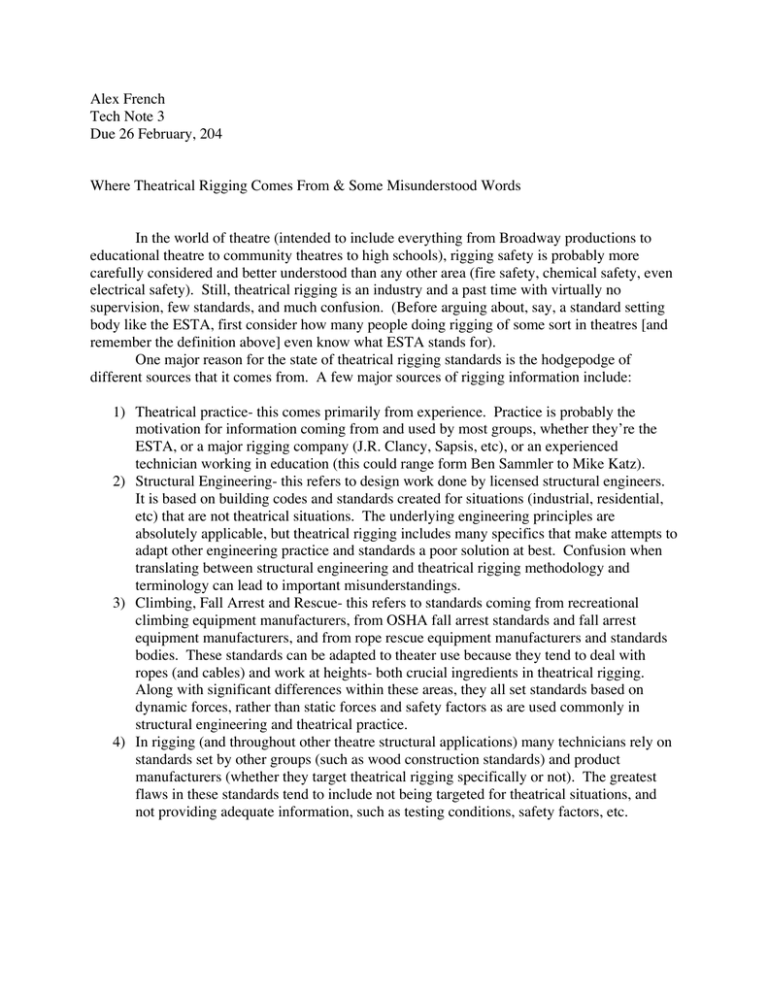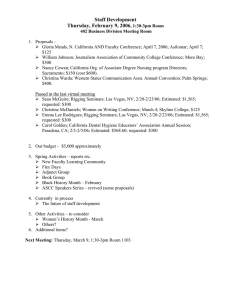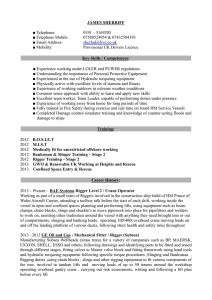Alex French Tech Note 3 Due 26 February, 204
advertisement

Alex French Tech Note 3 Due 26 February, 204 Where Theatrical Rigging Comes From & Some Misunderstood Words In the world of theatre (intended to include everything from Broadway productions to educational theatre to community theatres to high schools), rigging safety is probably more carefully considered and better understood than any other area (fire safety, chemical safety, even electrical safety). Still, theatrical rigging is an industry and a past time with virtually no supervision, few standards, and much confusion. (Before arguing about, say, a standard setting body like the ESTA, first consider how many people doing rigging of some sort in theatres [and remember the definition above] even know what ESTA stands for). One major reason for the state of theatrical rigging standards is the hodgepodge of different sources that it comes from. A few major sources of rigging information include: 1) Theatrical practice- this comes primarily from experience. Practice is probably the motivation for information coming from and used by most groups, whether they’re the ESTA, or a major rigging company (J.R. Clancy, Sapsis, etc), or an experienced technician working in education (this could range form Ben Sammler to Mike Katz). 2) Structural Engineering- this refers to design work done by licensed structural engineers. It is based on building codes and standards created for situations (industrial, residential, etc) that are not theatrical situations. The underlying engineering principles are absolutely applicable, but theatrical rigging includes many specifics that make attempts to adapt other engineering practice and standards a poor solution at best. Confusion when translating between structural engineering and theatrical rigging methodology and terminology can lead to important misunderstandings. 3) Climbing, Fall Arrest and Rescue- this refers to standards coming from recreational climbing equipment manufacturers, from OSHA fall arrest standards and fall arrest equipment manufacturers, and from rope rescue equipment manufacturers and standards bodies. These standards can be adapted to theater use because they tend to deal with ropes (and cables) and work at heights- both crucial ingredients in theatrical rigging. Along with significant differences within these areas, they all set standards based on dynamic forces, rather than static forces and safety factors as are used commonly in structural engineering and theatrical practice. 4) In rigging (and throughout other theatre structural applications) many technicians rely on standards set by other groups (such as wood construction standards) and product manufacturers (whether they target theatrical rigging specifically or not). The greatest flaws in these standards tend to include not being targeted for theatrical situations, and not providing adequate information, such as testing conditions, safety factors, etc. Looking at all the areas where “knowledge” in theatrical rigging may come from, it’s no surprise that many common and crucial terms are widely misunderstood. A few are discussed below: Safety Factor: Put simply, this is (estimated ultimate breaking strength) / (estimated static load). One common mistake in applying safety factors: Once you know about a factor affecting material strength, you can’t “deal with it” through a safety factor. A rope with an ultimate breaking strength of 10,000 lbs, knotted with a knot that decreases rope strength by 50% and loaded with 1,000 lbs, does not have a safety factor of 10. It has a safety factor of 5, because the knotting must be taken into account in the ESTIMATED ultimate breaking strength. Similarly, a rope that is worn does not warrant a higher safety factor, it warrants a decrease in the estimated ultimate breaking strength. Appropriate safety factors for theatrical rigging range from 5 to 20 depending on possible unknowns, possible damage to property and loss of life, and so on. Structural engineering uses total safety factors (which are often spread amongst several safety factors applied at different points in a design process) which are almost always lower than 2. Does this mean that theatrical rigging is safer, or is trying to be safer than structural engineers? No. Rigging, with inherently variable materials (ropes, knots) and many chances for user error (every piece of hardware in a system) uses large safety factors to compensate for poor information. Structural design can afford to use smaller safety factors because of greater knowledge about materials and quality control. In a single rigging system, it might be appropriate to use a safety factor of 20 (wire rope and connection hardware), 5 (pulleys, based on ultimate breaking strength, not manufacturer’s WLL) and of 1.5 (support steel). The Stage Rigging Handbook suggests the use of “design factor” rather than “safety factor” so as to not imply safety. This may be appropriate to distinguish theatrical magnitude safety factors, but “safety factor” continues to be the only appropriate term used in structural engineering. Safe Working Load: this is the load that can be applied based on a specific safety factor. A rope with an ultimate breaking strength of 10,000lbs, using a safety factor of 10, has a safe working load of 1,000lbs. Other terms used equivalently include SWL, Working Load Limit, WWL, Allowable Load Limit and ALL. “Rating”: I won’t define this term. It can’t be defined without making the term more specific. A manufacturer may rate the ultimate breaking strength of a piece of hardware or rope (even in this case, a specific description of the test used and related statistics can be important). They may also give a generic “load rating” or WLL. Without information about safety factors or at leas the context which it was rated for, this rating is essentially worthless. Hopefully the preceding discussion has helped clear up uncertainty in the use of several absolutely crucial terms. Understanding terminology is one tiny step toward being able to apply, in the best way possible, standards and practices drawing from diverse sources. Disclaimer: None of the information above should be used as a substitute for training and experience in theatrical rigging or any other area. When uncertain about safety, always consult an appropriate resource, whether that is the head rigger, an ESTA standard, a building code or a licensed structural engineer. This text draws from the following works, each of which is an accurate and clearly written reference for further study (in no particular format): Structural Design For The Stage by Alys Holden and Ben Sammler The Stage Rigging Handbook, Second Edition by Jay O. Glerum






